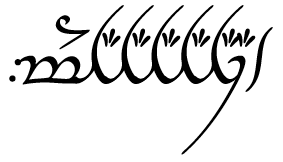
The reasons for getting an Elvish tattoo are many. It marks us to fellow fans. It’s a way to write a secret message on your skin for others who can read it. It proves to the world that you love Tolkien’s works. And most of all, it looks really cool! This is a list of things to consider when getting an “Elvish Tattoo,” written by a linguist who studies Tolkien’s Elven languages and translates for a lot of tattoos. This article is also useful for people who want to get “Elvish inscriptions” on things.
Elvish Basics
The tengwar are NOT a language. “Tengwar” means “letters” in Quenya. It’s just a writing system. It’s a very flexible writing system, where the letters are arranged in a grid, and they can be reassigned different sounds to fit different languages. That means that the tengwa “anta” is used for “NT” in Quenya, but for “DH” in Sindarin, and a hard “TH” when writing English. That means you can’t learn the writing system for one language and be able to go on to write in other languages. You basically have to relearn it for every language.
Speaking of that – there are two different ways to approach writing in English, which have very different uses of Tengwar. The first is writing English phonetically, based on how the words sound. Tolkien used it this way more often, when writing in his diary and for his own use. The upside of this is that we have lots of texts written this way, but the downside is that it’s based on his own dialect of English. If you don’t speak his dialect, then you’ll have to make changes to the script, and other people will have a harder time reading it. But when he wrote for others to see, like the inscription on The Lord of the Rings‘ title page, he wrote using a system based off of English orthography. This is what I recommend. Amongst English speakers, no matter how different our dialects, we still spell everything the same ways. (for the most part, anyways)
And other than those two, Phonetic and Orthographic, there are also the Mode of Beleriand/Northern Variety, which has vowels represented by Tengwar, and the Classical Mode/General Use, which has the vowels represented by Tehtar, which are marks added to Tengwar. The writing on The Lord of the Rings‘ title page is using Tehtar, as well as the famous writing on the One Ring. This is usually what people want, because the tehtar are really pretty. But Tolkien did develop a system for writing English with the vowels in the Tengwar. He wrote several drafts of a letter that Aragorn sent Sam before cutting it from The Return of the King. Some versions were in Sindarin, some in English, some with the Mode of Beleriand, some with the General Use mode. You can view these in Sauron Defeated, Part One, The Epilogue. Since it’s more famous, and people usually find it more aesthetically pleasing, I recommend using the General Use mode.
Now you know about the Tengwar, it’s time to choose the language. The Elven languages that Tolkien developed the most are Sindarin and Quenya. They are part of the same language family, but not mutually intelligible. Also, all translations not made by Tolkien are in Neo-Sindarin and Neo-Quenya. These are the languages expanded by fan theories and fan-made words. They are never made up from nothing – the theories and words are always based on something that Tolkien made. But unless you’re using a translation that Tolkien himself provided, the translation will be by necessity in some form of Neo-Elvish.
One important thing to know is that not all of Tolkien’s writings on his languages have been published yet. There are several groups of people putting together and publishing this data, but it takes a LONG time. It’s been Christopher Tolkien’s life’s work. The current state of things is that we know a lot more about Quenya than we know about Sindarin, since more of Tolkien’s notes and writings on Quenya have been published. As a language used amongst fans, Neo-Sindarin is still rapidly changing, because every publication brings to light fascinating new information on Sindarin grammar. That means translations from 10 years ago, even state-of-the-art ones, are obsolete now. A modern scholar can barely read the translations in the Lord of the Rings movies, the language has changed in our understanding of it so much. Therefore, if you want the language in the tattoo to be an Elven one, I suggest Neo-Quenya. If you want people who study the language to be able to read it in a few years, a Neo-Quenya translation is much less likely to become obsolete.
Finding a Translator
DO NOT use app “translators” or anything where you just put the English in one end and it automatically transcribes for you on the other end. Even the really good ones, like Tecendil, will make errors. These programs cannot sense context, like we humans can. Therefore, hilarious or tragic errors can result. You’ll see an all too common example later on in this article. Using Tecendil is fine for getting an idea of what it’ll look like, but it should not be your last stop.
Don’t try to do this on your own. Languages aren’t something you can easily pick up, especially not something as complex and alien as Tolkien’s languages. You want experts to help you. Human ones. Ones who have studied Tolkien’s languages in depth for at least 5 years. Some people do learn faster than that, true. But you, as someone who doesn’t know these languages, can’t know that. So, trust in time and experience. It’s not foolproof, not in any stretch of the word, but it’s better than nothing.
You also want the expert to be part of the Tolkien Language studying community. That way you can trust that they have at their disposal vast resources to help with the translation, and they have contacts that they can ask to check their translations for errors. Typos and simple errors affect EVERYONE, even someone who has studied for more than a decade. The way you check this is simple – if their website has a list of recommended websites for studying Tolkien’s languages, check that the list has a bunch of websites and resources. Everyone knows about Ardalambion and Parma Tyelpelassiva, you’ll want to check that they are also part of communities like the Discord chatroom Vinyë Lambengolmor. I can’t think of a good Tolkien language website that doesn’t acknowledge the community it’s a part of.
Fonts
This is kinda an offshoot of DON’T TRY TO DO THIS ON YOUR OWN, but it’s a really important topic, so I’m giving it its own section.
No Tengwar font uses a QWERTY keyboard layout. NONE OF THEM. You CANNOT plug in a font and type a text as you normally would. First off, Tengwar use punctuation differently than we do. Second, because the Tengwar are so different from the Latin alphabet, and since they don’t have capital letters, you can’t easily fit the Tengwar onto a QWERTY keyboard. Here. I’ll show you.
Here is a sentence you want to transliterate into Tehtar-Tengwar.
This is it just thrown directly into the font.
Here is a sentence you want to transcribe into Tehtar-Tengwar.
Here is what is says:
o fvf sj ch jfwmfwchf wwhrd bchwm mwh mvchwjchvsngf swmiwh fymchiv.fwnybchvw
Here is the same sentence transcribed correctly:
96FO ,G `C 81[F5$iË hyH y1[D 1`N 175#8z7w%( 5%1`N 1F91D6=1Fx#6-
And here is what I had to type to get that transliteration:
96FO ,G `C 81[F5$iË hyH y1[D 1`N 175#8z7w%( 5%1`N 1F91D6=1Fx#6-
A lot of the apps or websites that “translate” into Tengwar make this error, which is another reason to avoid them like the plague.
Guide to the most popular fonts:
Tengwar Annatar by Johan Winge: It’s clear, simple, and pretty. I used it above. But the reason everyone loves this one is that in italics, it looks like the personal handwriting of Sauron himself! (in other words, like the inscription on the One Ring.) Pictured is “Mwahahahahahaa!”

If you don’t want it to look like the handwriting of the villain of The Lord of the Rings, the next best one is:
Tengwar Telcontar by Johan Winge: It’s clear, simple, pretty, and designed by the same guy who made Tengwar Annatar, so of course it is. But even better, is that it uses its own set of Unicode designations! That means that the Tehtar automatically fit themselves onto the right part of the Tengwar when you type them, and the letters just flow and fit together more nicely. This, by far, is my favorite to use. It also doesn’t use a QWERTY keyboard, but it at least is a lot closer, and it’s much easier to memorize. Unfortunately, you can’t use this on very many writing programs. Word butchers it. I use it with LibreOffice Writer. Pictured is “I love you because you are special!”

Tengwar Teleri by Josh Griffing: It’s delightfully silly. It’s been designed to make the Tengwar look like stylized waterfowl. I love it. Maybe I’m the only one, but who cares! Pictured is “I don’t care, I love you!”

Translation/Transliteration Request Checklist
- Choose a language.
- Choose a writing system.
- Choose a font.
- Choose a translator.
With these things under your belt, you can be much more confident that your Elvish tattoo is meaningful and properly marks you as a real Tolkien fan.
If you want to make sure your tattoo artist won’t mess up all of this hard work you’ve done, give them this article: Basics of Tengwar for Tattoo Artists. I have a list of resources about Tengwar writing systems here: Trustworthy Websites – About Writing Systems and you can contact me, Fiona J., if you have questions on this topic. Translation/transcription checks are free. And that’s it! I wish you many happy inscriptions!

Hi! If I wanted to get “the road goes ever on” in a very fine line/sleek look – what would you recommend end where could I go to get a translation?
Mellon,
I am seeking to get a script tattoo in Quenya using Tehtar and Tengwar Telecontar.
Do you have a good translator recommendation?